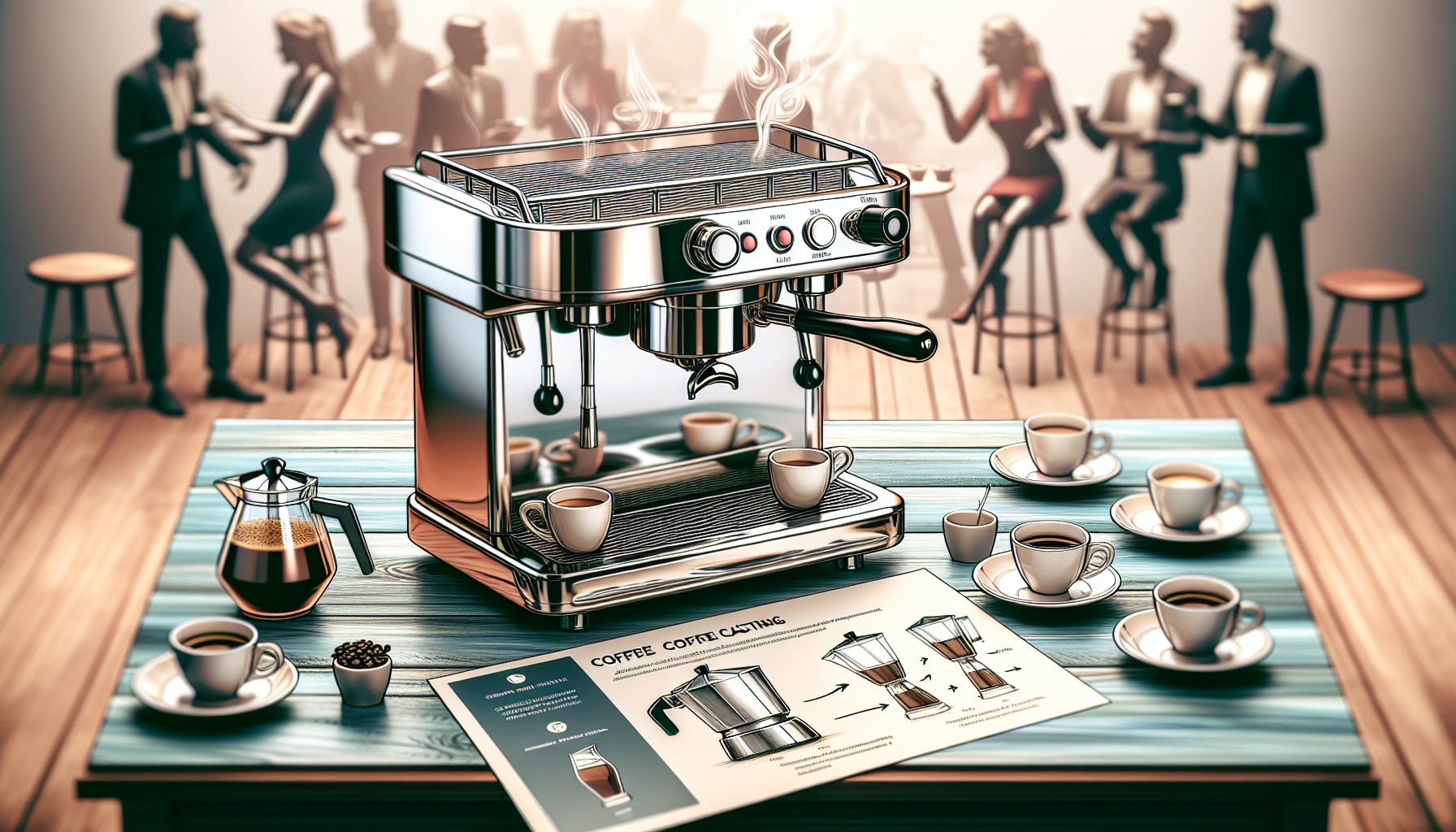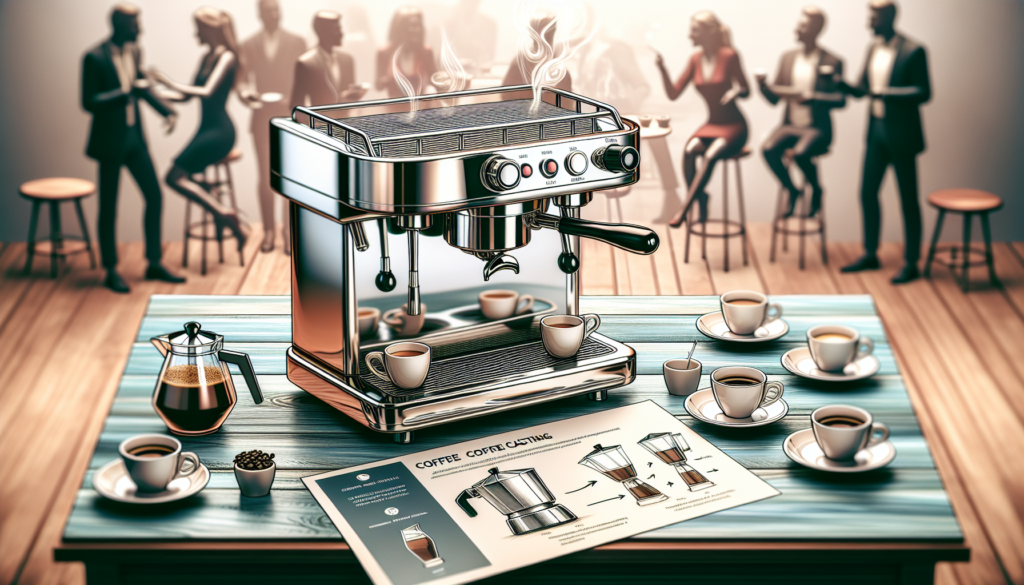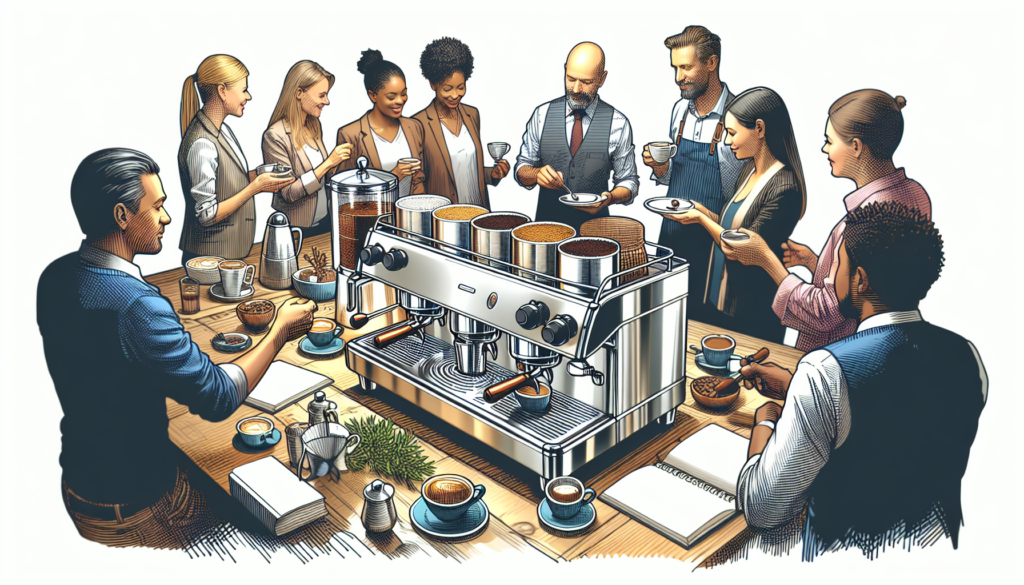
Imagine hosting a coffee tasting event that leaves your guests buzzing with excitement and appreciation for the rich aromas and flavors of freshly brewed espresso. With your trusty stainless steel espresso machine, you have all the tools you need to create a memorable and delicious experience. In this article, we will guide you through the steps to host your own coffee tasting event, from selecting the perfect coffee beans to showcasing the versatility of your espresso machine. Get ready to impress your friends and loved ones with your barista skills and take them on a coffee journey they will never forget.
Choosing the Right Coffee Beans
Consider the Roast Level
When choosing coffee beans for your tasting event, it’s important to consider the roast level. The roast level determines the flavor and intensity of the coffee. If you prefer a milder, lighter taste, go for a light roast. If you prefer a bolder, richer flavor, opt for a dark roast. Medium roasts fall somewhere in between. Consider your personal preference and the preferences of your participants when selecting the roast level.
Explore Different Origins and Varieties
Another important aspect to consider when choosing coffee beans is the origin and variety. Different regions around the world produce coffee with unique flavors and characteristics. Explore beans from various origins such as Brazil, Colombia, Ethiopia, and Costa Rica to experience the diverse tastes. Additionally, try different varieties like Arabica and Robusta to offer your participants a wide range of flavors to discover.
Decide on Single Origin or Blend
One decision you’ll have to make is whether to offer single origin beans or blends at your tasting event. Single origin beans come from a specific region or estate, allowing participants to explore the characteristics of a particular area. On the other hand, blends are carefully crafted combinations of multiple beans to create a balanced and complex flavor profile. Consider offering a selection of both single origin and blend options to cater to different preferences.
Consider the Bean’s Age
The age of the coffee beans can also have an impact on the flavor profile. Freshly roasted beans tend to have a more vibrant and pronounced taste, while older beans may have a mellower flavor. Consider the freshness of the beans you use for your tasting event and ensure they are within the optimal window for enjoying their flavors. This will ensure that your participants can fully appreciate the nuances of each coffee.
Preparing Your Espresso Machine
Clean and Descale the Machine
Before hosting a coffee tasting event, it’s essential to clean and descale your espresso machine. Regular cleaning removes any residue or impurities that may affect the taste of your coffee. Descaling is essential to remove any mineral buildup that can occur over time. Follow the manufacturer’s instructions for cleaning and descaling your specific espresso machine model to ensure it operates at its best.
Check the Grinder Settings
The grind size of your coffee beans can greatly impact the flavor and extraction of your espresso. Before the tasting event, check and adjust the grinder settings on your espresso machine to ensure a consistent and proper grind size. Experiment with different settings to find the ideal grind for the beans you’ll be using. A finer grind is generally used for espresso, while a coarser grind is suitable for other brewing methods.
Calibrate the Temperature
Temperature plays a vital role in the extraction of flavors from coffee. To ensure your espresso machine is calibrated correctly, use a reliable thermometer to verify the accuracy of the temperature settings. Make adjustments if necessary to ensure the water temperature is within the optimal range for brewing espresso. This will help guarantee that the flavors of the coffee beans are fully extracted and showcased during the tasting event.
Ensure Proper Water Filtration
Water quality is often overlooked but can significantly impact the taste of your coffee. Avoid using tap water that is high in minerals or impurities. Install a water filtration system or use filtered water to brew your coffee. This will help maintain the purity of the flavors and prevent any unwanted tastes from interfering with the tasting experience.

Setting Up the Coffee Tasting Event
Select a Suitable Venue
Choosing the right venue for your coffee tasting event is crucial to create the right ambiance and atmosphere. Consider a location that is spacious enough to comfortably accommodate your participants and the tasting area. If possible, opt for a venue with ample natural light and ventilation, as these factors can enhance the overall coffee tasting experience.
Set a Date and Time
Selecting the appropriate date and time is important to ensure maximum attendance. Consider the schedules and availability of your target audience when choosing a date. Additionally, think about the time of day that would be most suitable for a coffee tasting event. Typically, early afternoon or early evening slots work well, as participants can fully enjoy and appreciate the flavors without any time constraints.
Invite Participants
Once you have determined the date and time, it’s time to invite participants to your coffee tasting event. Reach out to coffee enthusiasts, friends, family members, or anyone who may be interested in exploring different coffee flavors. Provide them with the necessary details, including the venue, date, time, and any additional information they may need to attend the event.
Arrange the Tasting Area
Creating a well-organized and visually appealing tasting area can greatly enhance the coffee tasting experience. Set up a table with ample space to accommodate the necessary items, including the coffee samples, cups, and tasting cards. Arrange the items in a logical order that allows participants to easily navigate through the tasting process. Consider adding decorations or visual elements that reflect the theme of the event and create an inviting atmosphere.
Setting Up the Tasting Area
Provide a Variety of Cups and Glasses
To fully appreciate the flavors and aromas of different coffee samples, it’s important to provide a variety of cups and glasses. Different shapes and sizes can impact the way the coffee is perceived and enjoyed. Offer options such as espresso cups, small tasting glasses, and larger coffee mugs. This allows participants to experience the full range of flavors and intensities offered by each coffee.
Arrange the Coffee Samples
When setting up the tasting area, arrange the coffee samples in a way that makes it easy for participants to navigate through the tasting process. Place the coffee samples in a logical order, such as from lightest to darkest roast or from one origin to another. Clearly label each sample to avoid confusion and provide participants with a brief description of each coffee’s characteristics.
Set Up Tasting Cards and Pens
Providing tasting cards and pens for participants allows them to take notes and record their impressions of each coffee sample. Set up individual cards for each participant or have a communal tasting sheet where everyone can document their observations. Include spaces for participants to describe the aroma, flavor, body, and any other aspects they find noteworthy. This encourages engagement and helps participants remember their preferences.
Have Water and Palate Cleansers
Water and palate cleansers are essential during a coffee tasting event. Offer participants water to cleanse their palates between different coffee samples. This helps remove any lingering flavors and allows participants to fully appreciate each new coffee. Additionally, provide palate cleansers such as unsalted crackers or plain bread to further reset the palate and ensure accurate taste perceptions.

Tasting Techniques and Tips
Demonstrate Proper Cupping Technique
As the host of the coffee tasting event, it’s important to demonstrate proper cupping techniques to your participants. Show them how to engage their senses by observing the coffee’s appearance, inhaling its aroma, and then sipping and savouring the flavor. Guide them on how to hold the cup, slurp the coffee, and swish it around the mouth to fully experience the taste and body. This will help participants fully engage with the coffee and appreciate its complexities.
Guide Participants Through the Tasting Process
During the tasting event, guide your participants through the tasting process step by step. Explain the different elements to look for, such as aroma, acidity, body, and aftertaste. Encourage participants to take their time and savor each coffee sample, noticing how the flavors develop and change. Help them identify the unique characteristics of each coffee and guide them towards recognizing specific flavors or tasting notes.
Encourage Discussions and Note-taking
A coffee tasting event is not only about the flavors of the coffee but also about the shared experience and discussions it generates. Encourage participants to share their thoughts, opinions, and observations with each other. Foster a friendly and welcoming atmosphere that promotes open dialogue and allows participants to learn from one another. Encourage note-taking throughout the tasting process to help participants remember their preferences and engage in meaningful conversation.
Explain Flavor Profiles and Characteristics
As the host, provide participants with information about the flavor profiles and characteristics of each coffee sample. Share details about the origin, processing methods, and tasting notes. Explain the different flavors they may encounter, such as fruity, chocolatey, nutty, or floral notes. This information helps participants gain a deeper understanding of the coffee they’re tasting and enhances their appreciation for the complexities of each cup.
Creating a Tasting Menu
Choose Four or Five Coffee Varieties
When creating a tasting menu, it’s best to offer a manageable number of coffee varieties. Select four or five different coffees that represent a range of flavors, origins, and roast levels. This allows participants to explore different characteristics without feeling overwhelmed. Choose varieties that are distinct from each other to create a diverse and interesting tasting experience.
Organize the Tasting Order
The order in which the coffee samples are presented can greatly impact the overall tasting experience. Begin with lighter roasts and gradually progress to darker roasts. This allows participants to ease into the experience and fully appreciate the nuances of each coffee. Consider grouping the samples by origin or flavor profile to create a cohesive flow and logical progression throughout the tasting event.
Provide Background Information on Each Coffee
Offering background information on each coffee sample adds depth and context to the tasting experience. Share details about the origin, the processing methods used, and any unique aspects of each coffee. Provide participants with insights into the flavor profiles and tasting notes they can expect. This information gives participants a better understanding of what to look for and helps them appreciate the stories behind the coffee.
Offer Food Pairings
To enhance the tasting experience, consider offering food pairings that complement the flavors of the coffee. Pairing certain foods with specific coffees can bring out new flavors and create pleasant combinations. For example, a light and fruity coffee could be paired with a citrus-based dessert, while a bold and chocolatey coffee may pair well with a rich chocolate cake. Provide participants with suggestions for food pairings or even offer small samples of complementary treats during the tasting event.
Conducting the Coffee Tasting
Introduce the Tasting Menu
Before diving into the tasting, take a moment to introduce the participants to the coffee varieties they will be exploring. Share information about the flavor profiles, origins, and roast levels of each sample. Set the stage for a memorable tasting experience by igniting curiosity and anticipation among the participants.
Follow the Tasting Sequence
Guide the participants through the tasting sequence, starting with the lightest coffee and progressing towards the darkest or most robust flavors. Encourage participants to engage their senses fully, taking note of the aroma, flavor, body, and aftertaste of each coffee sample. Remind them to cleanse their palates with water and palate cleansers between each taste to ensure accurate perceptions.
Engage Participants in Discussion
Throughout the tasting, actively engage participants in discussion. Ask thought-provoking questions to stimulate conversation and encourage participants to share their impressions, preferences, and any unique insights they may have. Foster a friendly and inclusive environment where participants feel comfortable expressing their thoughts and engaging with others. This creates a dynamic and interactive tasting experience that helps deepen everyone’s understanding and appreciation of the coffee.
Encourage Comparison and Contrast
Encourage participants to compare and contrast the different coffees they taste. Prompt them to identify similarities and differences in flavor, body, aroma, and overall experience. By actively comparing and contrasting the samples, participants can develop a more refined palate and gain a deeper appreciation for the subtle nuances of each coffee variety.
Facilitating a Coffee Tasting Dialogue
Ask Thought-Provoking Questions
To facilitate a meaningful coffee tasting dialogue, ask thought-provoking questions that encourage participants to reflect on their tasting experience. Ask about their favorite coffee from the tasting and what specific aspects they enjoyed. Inquire about any unexpected flavors or characteristics they discovered. These questions help participants articulate their thoughts and encourage deeper engagement with the coffee samples.
Encourage Participants to Share Their Impressions
Throughout the tasting event, continuously encourage participants to share their impressions of each coffee. Create a safe and welcoming space where participants feel comfortable expressing their thoughts and opinions. Remind them that every tasting experience is unique, and their perceptions are valuable contributions to the discussion. This dialogue helps create a deeper connection between participants and cultivates a sense of camaraderie among coffee enthusiasts.
Discuss Brewing Techniques and Tips
Coffee tasting events are not only about tasting the final product but also about learning and sharing knowledge. Encourage participants to discuss brewing techniques and tips that they have found effective in bringing out the best flavors in coffee. This exchange of information allows participants to learn from each other’s experiences and take away practical advice to enhance their own coffee brewing skills.
Exchange Recommendations
As the tasting event progresses, participants will likely discover new coffee flavors and varieties that pique their interest. Encourage participants to exchange recommendations with each other, whether it’s for specific brands, origins, or brewing methods. This creates a sense of community and provides participants with opportunities for further exploration beyond the tasting event.
Promoting your Espresso Machine
Highlight the Features of Your Stainless Steel Espresso Machine
As the host of the coffee tasting event, take the opportunity to highlight the features and benefits of your stainless steel espresso machine. Emphasize its reliability, durability, and ability to produce consistent, high-quality espresso. Explain how the machine’s build materials, such as stainless steel, contribute to the overall performance and longevity. Showcase any unique features, such as temperature control or programmable settings, that set your espresso machine apart.
Offer Discounts or Promotions for Attendees
To incentivize participants to consider purchasing your espresso machine, offer exclusive discounts or promotions for event attendees. Provide them with a special code or offer that gives them a discounted price or additional benefits when purchasing the espresso machine. This creates a sense of urgency and value, making it more enticing for participants to invest in their own espresso machine.
Provide Product Demonstrations
During the tasting event, take the opportunity to provide product demonstrations of your stainless steel espresso machine. Show participants how to operate the machine, adjust the settings, and brew their own delicious espresso at home. Highlight its user-friendly design and showcase its capabilities. Seeing the machine in action can help participants visualize themselves enjoying their favorite coffee beverages at home.
Offer Assistance with Purchasing
Make it easy for participants to purchase your espresso machine by offering personalized assistance and support. Provide them with information on where and how to buy the machine, whether it’s through your own website, a retail partner, or a trusted online marketplace. Be available to answer any questions they may have and provide guidance on selecting the right espresso machine for their needs and preferences.
Conclusion
Reflect on the Tasting Event
After the coffee tasting event, take some time to reflect on the overall experience. Consider what went well and what could be improved for future events. Reflect on the participants’ engagement, the quality of the coffee samples, and the effectiveness of the setup and organization. This reflection helps you continually improve and refine your coffee tasting events.
Request Feedback
To gain valuable insights and further improve future events, ask participants for feedback. Provide them with a survey or a feedback form where they can share their thoughts on the tasting experience, the selection of coffees, the organization, and any other relevant aspects. Analyze the feedback and use it as a tool for growth and enhancement in your future coffee tasting events.
Offer Resources for Further Exploration
As a coffee enthusiast and host, it’s important to foster a love for coffee beyond the tasting event. Offer participants resources for further exploration such as recommended books, websites, or online communities where they can continue learning about coffee, brewing techniques, and different flavor profiles. Encourage them to continue exploring and expanding their coffee knowledge.
Express Gratitude to Participants
Finally, express your gratitude and appreciation to all the participants who attended your coffee tasting event. Thank them for their time, enthusiasm, and willingness to engage in the coffee tasting experience. Let them know that their presence and participation made the event a success. A sincere expression of gratitude creates a positive impression and fosters a continued connection with participants for future events or interactions.